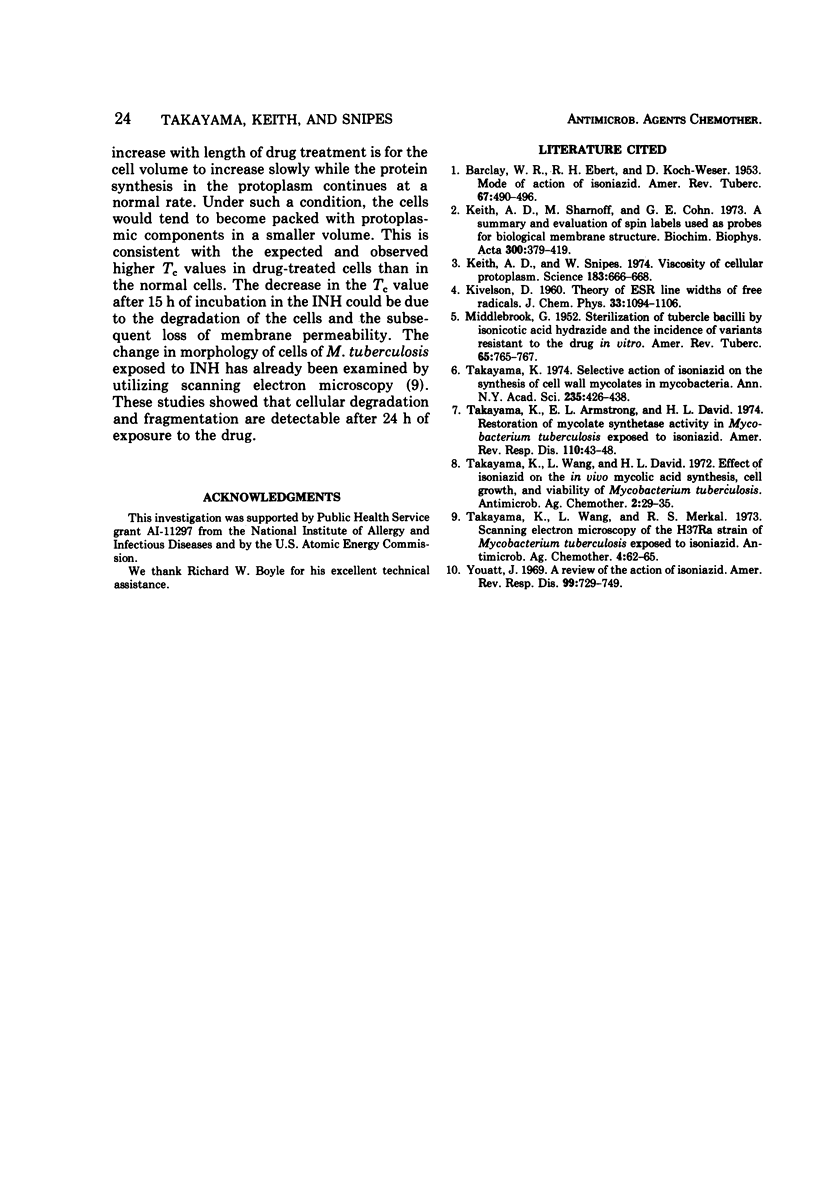Abstract
The effect of isoniazid on the protoplasmic viscosity in the H37Ra strain of Mycobacterium tuberculosis was determined by using electron spin resonance spectroscopy and a small spin label tempone (2,2,6,6-tetramethylpiperidone-N-oxyl radical). Isoniazid (0.5 μg/ml) caused the internal cellular viscosity to increase gradually over the first 15 h of exposure from a rotational correlation time value (Tc) of 2.4 × 10−10 to 3.4 × 1010 s and then decrease linearly to the control level after 27 h. These results could be interpreted to mean that isoniazid allows a continued and normal synthesis of the protoplasmic components while the rate of increase in the cell volume is reduced. A degradative process may begin after the initial 15-h exposure time, which would cause the reduction in the internal viscosity.
Full text
PDF


Selected References
These references are in PubMed. This may not be the complete list of references from this article.
- BARCLAY W. R., EBERT R. H., KOCHWESER D. Mode of action of isoniazid. Am Rev Tuberc. 1953 Apr;67(4):490–496. doi: 10.1164/art.1953.67.4.490. [DOI] [PubMed] [Google Scholar]
- Keith A. D., Sharnoff M., Cohn G. E. A summary and evaluation of spin labels used as probes for biological membrane structure. Biochim Biophys Acta. 1973 Dec 28;300(4):379–419. doi: 10.1016/0304-4157(73)90014-2. [DOI] [PubMed] [Google Scholar]
- Keith A. D., Snipes W. Viscosity of cellular protoplasm. Science. 1974 Feb 15;183(4125):666–668. doi: 10.1126/science.183.4125.666. [DOI] [PubMed] [Google Scholar]
- MIDDLEBROOK G. Sterilization of tubercle bacilli by isonicotinic acid hydrazide and the incidence of variants resistant to the drug in vitro. Am Rev Tuberc. 1952 Jun;65(6):765–767. [PubMed] [Google Scholar]
- Takayama K., Armstrong E. L., David H. L. Restoration of mycolate synthetase activity in Mycobacterium tuberculosis exposed to isoniazid. Am Rev Respir Dis. 1974 Jul;110(1):43–48. doi: 10.1164/arrd.1974.110.1.43. [DOI] [PubMed] [Google Scholar]
- Takayama K. Selective action of isoniazid on the synthesis of cell wall mycolates in mycobacteria. Ann N Y Acad Sci. 1974 May 10;235(0):426–438. doi: 10.1111/j.1749-6632.1974.tb43281.x. [DOI] [PubMed] [Google Scholar]
- Takayama K., Wang L., David H. L. Effect of isoniazid on the in vivo mycolic acid synthesis, cell growth, and viability of Mycobacterium tuberculosis. Antimicrob Agents Chemother. 1972 Jul;2(1):29–35. doi: 10.1128/aac.2.1.29. [DOI] [PMC free article] [PubMed] [Google Scholar]
- Takayama K., Wang L., Merkal R. S. Scanning electron microscopy of the H37Ra strain of Mycobacterium tuberculosis exposed to isoniazid. Antimicrob Agents Chemother. 1973 Jul;4(1):62–65. doi: 10.1128/aac.4.1.62. [DOI] [PMC free article] [PubMed] [Google Scholar]
- Youatt J. A review of the action of isoniazid. Am Rev Respir Dis. 1969 May;99(5):729–749. doi: 10.1164/arrd.1969.99.5.729. [DOI] [PubMed] [Google Scholar]


